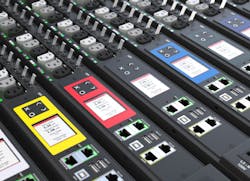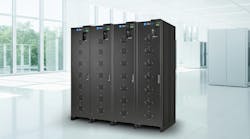How Power Quality Intelligence Can Drive Data Center Sustainability Efforts
To measure their success at sustainability initiatives, many data center operators use The Green Grid’s Power Usage Effectiveness (PUE) as a metric to evaluate the energy efficiency of their data center. PUE is calculated by dividing the total amount of power used by the data center by the power used by the IT equipment. The resulting ratio indicates how much of the energy consumed by the data center is actually being used for productive IT work. A lower PUE means that the data center is using energy more efficiently and wasting less. Improving PUE is a key way for data centers to improve their environmental sustainability and reduce their carbon footprints. Proper power quality monitoring can help data centers identify areas of inefficiency and waste, allowing them to make improvements to their infrastructure and ultimately reduce their PUE.
The problem is that some data centers lack the level of power monitoring capability that they truly need in order to drive greater efficiency and sustainability. There is also an even greater need for continuous power quality monitoring that is not being met. Many are relying on the more basic voltage, current and power parameters captured by intelligent rack PDUs that are passed through to DCIM, BMS and other infrastructure management and monitoring offerings. Others take power quality into account as a one-time evaluation during start-up and only come back to it when there’s a need to retool IT configurations. All of this places greater emphasis on the importance of the intelligent PDU in providing power quality monitoring and the need that data center and facility managers have to drive efficiency and sustainability.
Some examples of the types of power quality issues that can negatively impact the electrical reliability of a data center, cause unplanned expensive downtime and create difficulties improving sustainability include:
- Voltage sags and dips: These short-term reductions in voltage levels can cause IT equipment to shut down or reboot, leading to data loss or system crashes.
- Harmonic distortion: This electrical noise can cause overheating of IT equipment, leading to damage and premature failure. Harmonic distortion can also cause interference with data transmission, leading to errors and diminished network performance.
- Power outages: Complete losses of power can cause data loss or corruption, as well as equipment damage.
- Frequency variations: These changes in the frequency of the AC power supply can cause IT equipment to malfunction or shut down.
- Voltage swells: These short-term increases in voltage levels can cause IT equipment to malfunction or fail.
All of these power quality issues can have significant impacts on a data center's operations and overall reliability. They can cause unplanned downtime, equipment damage, data loss or corruption, and diminished network performance. Lack of available power metrics can also hinder the ability of data center operators to identify stranded capacity, keeping them from optimizing space and usage effectively and sustainably. Therefore, it is critical for data centers to implement reliable and intelligent power distribution solutions that can capture many of these details to mitigate these power quality issues and ensure continuous operation of their IT infrastructure.
The problem is that while intelligent rack power distribution units offer a host of advanced features, many of them do not provide granular visibility into power quality data at the rack and outlet level. The reason for this is that many intelligent PDUs do not have the proper monitoring capabilities embedded in them to provide detailed power quality data. In many cases, intelligent PDUs are designed to monitor only a limited set of parameters such as voltage, current and power. While this data can provide some insights into the overall health of the data center's electrical infrastructure, it does not provide the granular data needed to identify specific power quality issues that can impact individual racks or devices. This lack of detail makes it difficult for data center managers to identify and address power quality issues before they become major problems. The need for a new generation of reliable, intelligent rack power distribution, monitoring and control solutions has never been greater.
So, what should the ideal intelligent PDU provide? The ideal PDU for powering sustainability in data centers offers all-in-one intelligence for visibility, reporting and alerting power and power quality metrics at the cabinet level along with flexibility to meet future data center requirements.
Selecting a Rack PDU
To confidently meet the ever-changing rack power monitoring and infrastructure needs of modern data centers, rack PDUs are going to need to be equipped with future-focused capabilities. This includes advanced power quality monitoring, metrics, real-time alerting, and precision (±0.5%) accuracy. Within this framework, PDUs will need to provide visibility of peak and min/max power measurement values. This will help provide beneficial insights for capacity planning, identifying stranded capacity, and for failover planning. Furthermore, total harmonic distortion measurements at the PDUs that offer circuit breaker trip forensics make it possible for data center operators to uncover the exact location and cause of the trips and interruption to operations. Along with identifying the outlet, a truly intelligent PDU should capture the associated waveform so that it can be reviewed, thereby facilitating troubleshooting efforts and allowing power to be restored to non-offending equipment sooner.
In addition to the intelligence capabilities of the PDU, high density is also critical to forward-thinking data centers. Currently, some data center and facility managers gravitate to supplying off-the-shelf power strips to meet their density requirements. This approach can lead to needing to specify more PDUs, more power infrastructure and absorbing more cost. This approach may also fail to give them access to the right number, type or configuration of outlets. Data center professionals who want to be prepared for future equipment density and change requirements should look for high-density and flexible outlet configuration in PDUs. Having this capability in one PDU can facilitate the use of high-input power capacity in smaller spaces, allowing more devices to be powered in the cabinet with lower cost and less infrastructure required.
Data center operators should also look for the following benefits in their rack power distribution units:
- Real-time visibility, reporting and alerting of power metrics and events
- Best-in-class flexibility to meet and anticipate future requirements
- Engineered for mission-critical uptime
- Unsurpassed outlet and power density
- Easy data collection and export to manage energy utilization
- Secure encrypted communication, by default, for all PDU data
Improved visibility into power quality data enables facility managers to troubleshoot the sources of inefficiency that can lead to wear and tear on equipment as well as prevent downtime. This can free up time, attention, and capital to pursue other sustainability efforts. PDUs must be more than simply power strips in order to provide the power quality monitoring necessary to enable data center PUE to improve.
Calvin Nicholson is Senior Director of Product Management at Legrand’s Data, Power, and Control Division, which includes the Server Technology and Raritan brands. Server Technology has launched the advanced PRO4X Intelligent PDU, which provides data centers with visibility into their operations to help them drive their sustainability efforts forward. Discover more about the PRO4X PDU.



